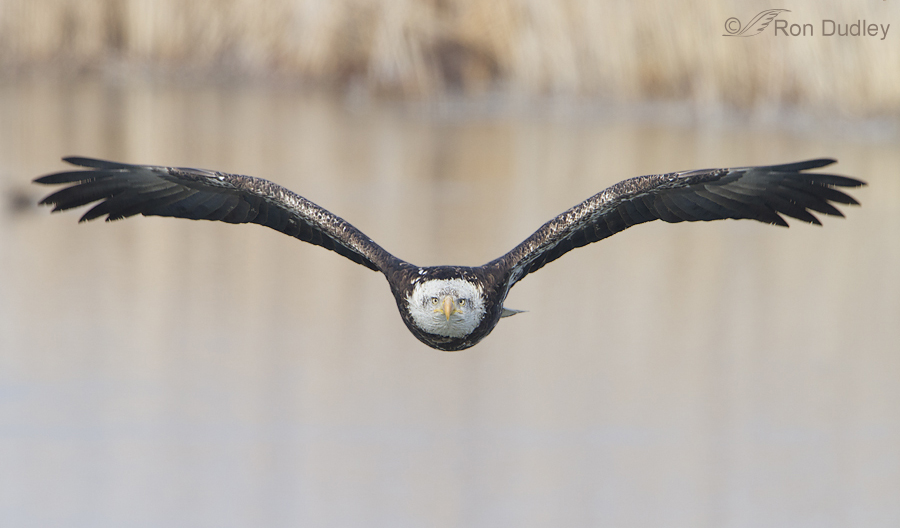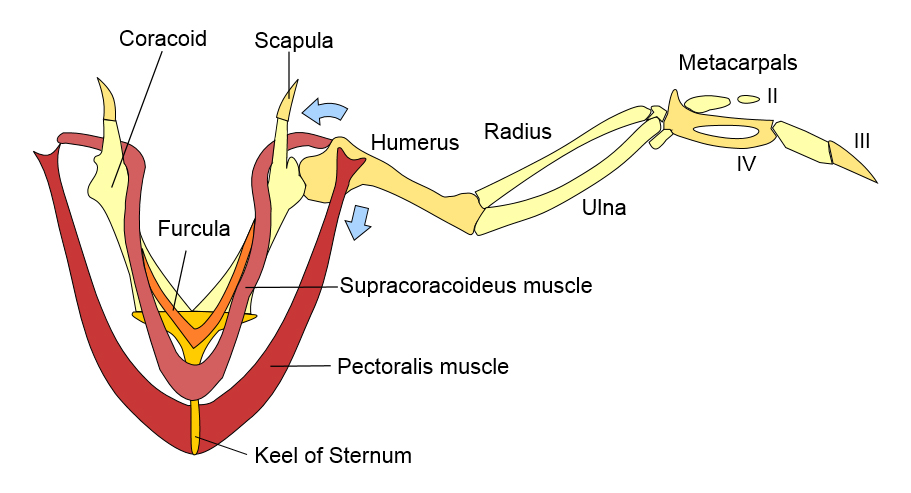When I was teaching high school zoology I was fascinated by the many adaptations of birds for flight. Still am. One of them is a unique muscle arrangement that allows the return stroke of the wing while maintaining aerodynamic stability. I hope you’ll allow me a little change in direction with today’s post as I attempt to explain and illustrate one of the anatomical adaptations of birds for flight.
The body of a bird basically hangs down from the wings during flight. The wings attach high on the body and the huge breast muscle (pectoralis) lies below that attachment. This arrangement provides a low center of gravity and aerodynamic stability. The pectoralis muscle attaches to the keel of the sternum and the humerus of the wing so when that muscle contracts it provides the powered down-stroke of the wing.
But one of the dilemmas of bird flight is how to design a muscle arrangement that will power the upstroke of the wing and still maintain that low center of gravity. Muscles can only contract under power so it seems logical that the muscle that would provide the upstroke would be along the back. But such an arrangement would place a relatively large muscle mass high on the body, raise the center of gravity and compromise aerodynamic stability. Anyone who has ever eaten a chicken back knows that there is very little meat (muscle) there and that particular placement of the muscle along the back is not the solution that nature came up with.
So how was the problem solved?…
By L. Shyamal [CC-BY-SA-2.5 (http://creativecommons.org/licenses/by-sa/2.5)], via Wikimedia Commons
The solution is truly ingenious.
In this graphic you can see how the contraction of the pectoralis would power the wing down. But beneath and lying next to the pectoralis is another muscle – the supracoracoideus (the word is a mouthful, I know. It means “above the coracoid” bone). The supracoracoideus is antagonistic to the pectoralis and provides the upstroke. It is attached to the upper side of the humerus by a unique “rope and pulley” arrangement of a tendon that travels up and over a notch in the scapula before attaching to the humerus. So even though the muscle is below the humerus, the direction of pull is from slightly above so that when it contracts it raises the wings and aerodynamic stability is maintained.
Most folks are very familiar with the supracoracoideus, they just don’t know the formal name. Chicken “tenders” are the supracoracoideus muscle of that domestic fowl. When we eat a chicken breast the supracoracoideus is the shiny, more tender piece of meat lying between the larger mass of the breast (pectoralis muscle) and the bone. If you’ve ever deboned a chicken breast you’ve likely noticed (and removed) the tendon coming off the “tender”. That tendon is the one that attaches to the humerus and provides uplift to the wing.
The graphic above is misleading in a couple of ways (it’s the only appropriate Creative Commons graphic I could find). The graphic shows a large space between the pectoralis and the supracoracoideus, a space that does not exist. The two muscles actually lie atop one another and are separated only by a very thin membrane. The graphic also shows the tendon to be as large in diameter as the muscle itself when in reality the tendon is something like a narrow string coming out of the much larger muscle.
I realize this post won’t be everyone’s cup of tea but I’m also aware that some folks (me included) like to know everything they can about their beloved birds. This post is for you…
Tomorrow I’ll get back to more standard fare.
Ron
Many thanks to L. Shyamal for providing the graphic to Creative Commons.




Another great lesson, Ron! Thank you so much for this type post. I keep hoping the more I learn about my favorite subjects, the better photographer and birder I may become. Well, it’s just a theory……
(I hope the test will be multiple choice.)
Ron:
Great! I enjoyed that. From the response, mine included, similar posts would be well received.
Perhaps you’ve read this, but just in case …. you and Chuck would be interested in
Why Don’t Jumbo Jets Flap Their Wings?
Flying Animals, Flying Machines, and How They Are Different
by David E. Alexander
Dave
Ron, one of the reasons I started birding after I retired from a rewarding career as a research scientist is because it provided a way for me to learn a new discipline and to stay connected to the biological sciences. It has been way too many years since my comparative anatomy days but I really enjoyed your refresher course. I learn a lot from you and Mia so keep the lessons coming.
Supercallafragelicious…
Thanks Ron, I am always happy to learn. And marvel at birds on a daily basis.
It is fascinating and thanks for sharing the information in such a clear form.
I’m glad it was clear and understandable, Sonja. That’s one of the biggest challenges of “teaching”. Thanks for the feedback on that.
Love this post! Avian anatomy fascinates me too Ron. I’ve spent a bit of time taking birds apart and looking at this and that. I’d absolutely love more posts like this. It’s ingenious to supplement some facts with your smashing photography. Well done once again.
Thanks very much for the encouragement, Bryce. I suspect I will do posts like this from time to time.
Thanks for the lesson. I never thought a lot about how birds fly.
I vaguely thought the pectoralis took care of everything.
I suspect a lot of folks believe the same thing, Jack. Thank you.
This is fascinating. I never really thought about how birds flew before, but I am not surprised by the ingenious design. It’s right in keeping with the rest of how amazing birds are. Thank you for posting this.
You’re very welcome, Susan. I’m glad you enjoyed the post.
Fascinating.
I’m glad you thought so, Leisa. Thanks.
Ron, here is a diagram that shows a closer proximity of the two muscle groups so hopefully this link works.
http://i17.photobucket.com/albums/b64/smunster/Diagrams/5eee6d58-03e7-4c51-8133-6f306277032f.jpg
Bill
Yes, the relative sizes and position of the two muscles looks much better there, Bill. Thanks for the link.
That was so great Ron. Thanks for being such a great teacher. I don’t know if I will ever eat chicken again!!!
Your “chicken” comment made me smile, Ellen.
Can you actually pronounce that? I know Mary Poppins can.
It’s really not hard… 🙂 (It may help that I studied human anatomy in my youth.)
Susan’s right, Patty. After saying it a couple of times it rolls off the tongue pretty easily.
Ron, I really appreciate these lessons. They help me comprehend the miracle of flight on a more visceral level. Knowledge enhances wonder.
“Knowledge enhances wonder.”
You hit the nail on the head with that statement, Alison.
Ron: I love this, and thanks for posting this. I would love to see even more posts like these, since I also studied human anatomy and like to compare them (although I still think bird’s anatomy is much more specialised, fascinating, and adapted than ours). How do you explain feathers? I would love to hear your take on this (or an explanation). Ron, I was also curious as to what your opinion was on the new Canon 70D?
I held it in my hands yesterday and it disappointed me with its size. Or are you still waiting for the 7D upgrade?
Maria, For many years it was held that feathers are modified scales (that’s what I taught to my students for a long time) but newer information suggests it’s not as clear-cut as that. Perhaps that could be a subject for a future post…
No, I’m not interested in the 70D. The upgrade of the 7D is supposed to be released in the first half of next year and I’ll wait for that.
Very cool…Jeremy and I think this kind of post is terrific. Thanks for the info…and if only we’d had a biology or zoology teacher like you…
I appreciate the nice “teacher” compliment, Sharon.
Informative and interesting post Ron. Thank you !
Thanks, John.
Ron. Great article. I really enjoyed it, especially since I just spent 10 days photographing bald eagles in Alaska. Magnificent birds and now I understand more about their flight.
Thank you
Thank you, Keith. I’m jealous of your time in Alaska with the eagles but I suspect I’ll be seeing many of those same birds in a few weeks down here in my “neighborhood”.
Very interesting! Chicken tenders! And this also helps to explain the wish bone, too, I think. Thank you and I love the shot of the eagle.
Thanks, Tana. If I remember correctly the function of the wishbone (furculum) is to make the thoracic area of a bird more rigid, thus providing additional stability in flight.
Tana: Not sure if your realize the wish bone (clavicles or furcula) are not the same bone as the coracoid. I posted this diagram some time ago on a different bird discussion but here it is again:
http://i17.photobucket.com/albums/b64/smunster/Diagrams/5b51b4cc-eb06-45ac-be15-247aa7acc849.jpg
I’m sure Ron enjoys the receptic attitude to the offered information. Its the reason I participate in these discussions. As a former teacher I also find it hard to remove it from one’s system. LOL
Excellent essay Ron! Understanding the aerodynamics of flight is certainly not everyone’s thing, but for one who is moved by the remarkable beauty of birds, this additional information, for me at least- elevates the “awe factor” and increases the passion further.
Chuck, I figured that you, as a pilot, might appreciate some of this information. Thank you.
Thanks Ron for this post. I love learning all about birds and their anatomy and physiology fascinate me as well.
Post more if you wish. I will enjoy it as well.
I probably will occasionally, Sandi – won’t be able to resist. Thanks for the encouragement.
Wonderful information, Ron. I’m an avian rehabber, (native songbirds and raptors) who has dealt with many a fractured coracoid. I’ve found that approximately 70-75% of fractures will heal on their own if the bird is kept in restrictive housing. Cooper’s hawks and sharp shinned hawks may be the exception to this, given their “manic” disposition, but I’ve had a few successes with them. Avian anatomy simply amazes me, what it takes for a bird to achieve, then maintain, flight. Nothing short of miraculous.
“Avian anatomy simply amazes me, what it takes for a bird to achieve, then maintain, flight.”
It amazes me too, Leslie. Birds are a marvel of design.